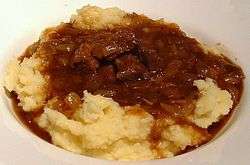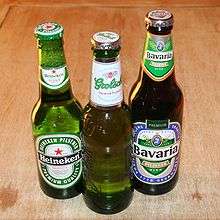Dutch cuisine
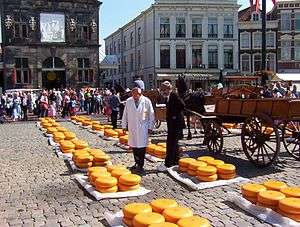
Dutch cuisine (Dutch: Nederlandse keuken) consists of the cooking traditions and practices from the Netherlands. The country's cuisine is shaped by the practice of fishing and farming, including the cultivation of the soil for raising crops and the raising of domesticated animals, and the history of the Netherlands.
Traditionally, Dutch cuisine is simple and straightforward, with many vegetables and little meat; breakfast and lunch are typically bread with toppings while dinner is meat and potatoes, supplemented with seasonal vegetables. The Dutch diet was relatively high in carbohydrates and fat, reflecting the dietary need of the laborers whose culture molded the country, and contains many dairy products. Without many refinements, it is best described as rustic, though many holidays are still celebrated with special foods. In the course of the twentieth century this diet changed and became much more cosmopolitan, with most international cuisines being represented in the major cities.
History

12th–13th century
Little evidence is available about food and drink in the late medieval Low Countries. In the consumption of pottage, the Low Countries were not very different from other Western European countries during the Middle Ages. Half-liquid pottage consisted of milk, beer, water, root vegetable and peas or grain, sometimes enriched with a piece of meat. The content changes throughout the seasons.[1]
Beer flavoured with gruit was produced until the 14th century at the monasteries. Gruit was replaced with hop, a tradition introduced from the German city of Bremen, and this started off a beer culture and the Low Counties as a major exporter of beer. Beer was in medieval times the common drink as water was of poor quality, and milk -coming from the low-lying grasslands of Holland and Friesland - was mainly used for the production of butter and cheese. Dutch butter and cheese became famous products at an early stage and continued to do so for centuries.[1]
14th–15th century
The sea and the rivers provided in abundance of fish. The process of gibbing was invented by Willem Beukelszoon,[2] a 14th-century Zealand fisherman. The invention created an export industry for salt herring (Dutch: maatjesharing) that was monopolized by the Dutch. They began to build ships and eventually moved from trading in herring to colonizing and the Dutch Empire, ultimately leading to the Dutch becoming a seafaring power.[3] Herring is still very important to the Dutch who celebrate Vlaggetjesdag (Flag Day) each spring, as a tradition that dates back to the 14th century when fishermen went out to sea in their small boats to capture the annual catch (Hollandse Nieuwe), and to preserve and export their catch abroad.
Gardening was initially practiced by monasteries, but castles and country houses began also to develop gardens with herbs and vegetables and hunting grounds. The famous tourist attraction and flower park Keukenhof (literally kitchen garden) is an example of a former 15th-century hunting ground and herbs garden for Jacqueline, Countess of Hainaut's castle kitchen. Orchards for pears and apples connected to castles were later used for export and set off a Dutch horticulture tradition until today.[1]
During the 15th century haute cuisine began to emerge, largely limited to the aristocracy. Cookery books from this period are aimed at the upper class. The first Dutch-language cook book printed in Brussels is called Een notabel boecxken van cokeryen (A notable book of cookery). It offers medieval recipes for festivities, such sauces, towel, game, jellies, fish, eat, pies, tarts, eggs dairy products, candied quinces and ginger. The recipes come from various sources, many of the French. Historically, Dutch cuisine was closely related to northern French cuisine, since the two countries have nearby borders and the Low Countries and Northern France have been historically ruled by the Dukes of Burgundy. This is still visible in traditional Dutch restaurants and the Southern regional cuisine, that is still colloquially referred to as Bourgondisch.[1]
16th–17th century
As the Dutch Republic enters its Golden Age in the 17th century, dishes of this kind became available to the wealthy middle class as well, often consisting of a rich variety of fruits, cheeses, meat, wine, and nuts.[4][5] The Dutch Empire enabled spices, sugar, and exotic fruits to be imported to the country. The Dutch East India Company was the first to import coffee on a large scale to Europe.[6] The Dutch later grew the crop in Java and Ceylon.[7] The first exports of Indonesian coffee from Java to the Netherlands occurred in 1711.[8] By the late 17th century, tea and coffee consumption were increasing and becoming part of everyday life. Tea was served with sweets, candy or marzipan and cookies. The availability of relative cheaper spices resulted in a tradition of spiced cookies called speculaas, which exact recipes were kept secret by bakers.[9]
Vegetables, meat, poultry and salted, smoked or fresh fish and egg was prepared in the Dutch kitchens of the time.[10][11] The meal started with green salads and cold or warm cooked vegetables with dressing, vegetable dishes with butter, herbs or edible flowers and continued with numerous fish- and meat dishes. Exotic ingredients such as dates, rice, cinnamon, ginger and saffron were used. Savory tarts and pastries followed. The meal ended with jellies, cheese, nuts and sweet pastries, washed down with sweet spiced wine.[12] Of course, even in the Golden Age, not everyone could afford such luxuries and the everyday meal of the ordinary Dutchman was still a humble affair of grain or legume pottage served with rye.[13]
- Dutch Golden Age - historical cuisine
 Kitchen scene from 1644, by David Teniers the Younger
Kitchen scene from 1644, by David Teniers the Younger'_by_Pieter_Claesz.%2C_Cincinnati.jpg) Mince pie and Lemon by Pieter Claesz, 1625
Mince pie and Lemon by Pieter Claesz, 1625 Clara Peeters (1594–1657) Still Life with Crab, Shrimps and Lobster
Clara Peeters (1594–1657) Still Life with Crab, Shrimps and Lobster.jpg) Clara Peeters (1594–1657) Table with Orange, Olives and Pie
Clara Peeters (1594–1657) Table with Orange, Olives and Pie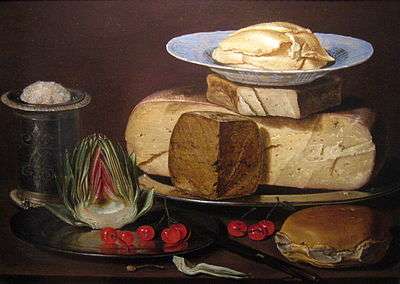 Clara Peeters (1594–1657) Still life with Cheeses, Artichoke, and Cherries
Clara Peeters (1594–1657) Still life with Cheeses, Artichoke, and Cherries Still-Life with fruit, nuts and cheese by Floris Claeszoon van Dyck
Still-Life with fruit, nuts and cheese by Floris Claeszoon van Dyck
18th–19th century

In the 18th century the potato gained popularity, to become a staple food by 1800.[14] In the early 1800s, while the rich could eat what they desired, the working population ate bread (rye bread in some areas) and potatoes, pancakes in some areas, occasionally fish and other seafood, fruit and vegetables, but usually little meat: "the diet of the Dutch in the nineteenth century consisted of some bread, and a great deal of potatoes". Diet consisted in a frugal fashion, of such simple dishes as bread and herring. Throughout the nineteenth century many people suffered from some mild form of malnutrition.[14]
Potatoes, in fact, were often eaten at every meal, every day of the week. They were peeled and boiled for the main meal, lunch, and then warmed and mashed for dinner, with leftovers saved for breakfast. They were served with salt, sometimes vinegar, but without gravy or any other fat, making for a diet with "incredible monotony".[14]
During the nineteenth century, the poor people drank little else but water (of poor quality), sometimes watery coffee (or chicory) or tea. In some areas hot chocolate was consumed, but the most popular drinks (beside water) were beer and jenever. For most of the century beer was drunk in the southern part, where Catholicism dominated, and in Catholic enclaves in the other areas. This beer was top-fermented and of terrible quality; not until the 1880s did German-style bottom-fermented pilsner enter the Dutch market. Jenever consumption early in the nineteenth century was twice that of the equivalent consumption of distilled in neighboring countries.[14]
20th–21st century
The modest and plain look of what is nowadays considered the traditional Dutch cuisine, appears to be the result of a fairly recent development. In the twentieth century, the new availability of mass education meant that a great number of girls could be sent to a new school type, the Huishoudschool (housekeeping school), where young women were trained to become domestic servants and where lessons in cooking cheap and simple meals were a major part of the curriculum, often based on more traditional Dutch dishes, and leading to increased uniformity in the Dutch diet. Values taught in that school system included frugality, proper (table) manners, and healthy eating.[15]
Regional cuisines
Modern culinary writers distinguish between three general regional forms of Dutch cuisine.[16]
Northeastern cuisine
The regions in the north and east of the Netherlands, roughly the provinces of Groningen, Friesland, Drenthe, Overijssel and Gelderland north of the great rivers make up north eastern Dutch cuisine.
The region is the least populated area of the Netherlands; and the least developed part. The late (18th century) introduction of large scale agriculture means that the cuisine is generally known for its many kinds of meats. The relative lack of farms allowed for an abundance of game and husbandry, though dishes near the coastal regions of Friesland, Groningen and the parts of Overijssel bordering the IJsselmeer also include a large amount of fish.
The various dried sausages, belonging to the metworst-family of Dutch sausages, are found throughout the region and are highly prized for their often very strong taste. Most towns and various villages have their own variety of this sausage. The region also produces the traditional smoked sausages, of which (Gelderse) rookworst is the most renowned. These sausages traditionally have been smoked over wood chips, and are served after they have been boiled in water. The sausage contains a lot of fat and is very juicy. Larger sausages are often eaten alongside stamppot, hutspot or zuurkool (sauerkraut); whereas smaller ones are often eaten as a street food.
The provinces are also home to rye bread (a kind of Pumpernickel) and many kinds of pastries and cookies. In contrast to southern Dutch cuisine, which tends to be soft and moist, the northeastern rye bread and pastries generally are of a hard texture, and the pasties are heavily spiced with ginger or succade or contain small bits of meat. Various kinds of Kruidkoek (such as Groninger koek), Fryske dúmkes and spekdikken (small savory pancakes cooked in a waffle iron) are considered typical.
Each of the provinces of Gelderland, Overijssel and Groningen has a long-standing rye bread tradition, but rye bread from Friesland became well known because of its taste. Notable characteristics of Fries roggebrood (Frisian rye bread) is its long baking time (up to 20 hours), resulting in a sweet taste and a deep dark colour.[17]
In terms of alcoholic beverages, the region is renowned for its many bitters (such as Beerenburg) and other high-proof liquors rather than beer, which is, apart from Jenever, typical for the rest of the country.
As a coastal region, Friesland is home to low-lying grasslands, and thus has a cheese production in common with the Western cuisine. Friese Nagelkaas (Friesian Clove) is a notable example.
Western cuisine

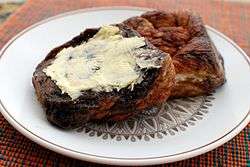
The provinces of North Holland, South Holland, Zeeland, Utrecht and the Gelderlandic region of Betuwe are the parts of the Netherlands which make up the region in which western Dutch cuisine is found. The area is known for its many dairy products, which includes prominent cheeses such as Gouda, Leyden (spiced cheese with cumin), Edam (traditionally in small spheres) as well as Leerdammer and Beemster, while the adjacent Zaanstreek in North Holland is since the 16th century known for its mayonnaise, typical whole-grain mustards[18] and chocolate industry.
Zeeland and South Holland produce a lot of butter, which contains a larger amount of milkfat than most other European butter varieties. A by-product of the butter-making process, karnemelk (buttermilk), is also considered typical for this region.
Seafood such as soused herring, mussels (called Zeeuwse Mossels, since all Dutch mussels for consumption are cleaned in Zeeland's Oosterschelde), eels, oysters and shrimps are widely available and typical for the region. Kibbeling, once a local delicacy consisting of small chunks of battered white fish, has become a national fast food, just as lekkerbek.
Pastries in this area tend to be quite doughy, and often contain large amounts of sugar; either caramelised, powdered or crystallised. The oliebol (in its modern form) and Zeeuwse bolus are good examples. Cookies are also produced in great number and tend to contain a lot of butter and sugar, like stroopwafel, as well as a filling of some kind, mostly almond, like gevulde koek.
The traditional alcoholic beverages of this region are beer (strong pale lager) and Jenever, a high proof juniper-flavored spirit, that came to be known in England as gin. A noted exception within the traditional Dutch alcoholic landscape, Advocaat, a rich and creamy liqueur made from eggs, sugar and brandy, is also native to this region.
Southern cuisine
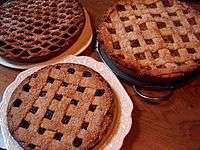
Southern Dutch cuisine constitutes the cuisine of the Dutch provinces of North-Brabant and Limburg and the Flemish Region in Belgium. It is renowned for its many rich pastries, soups, stews and vegetable dishes and is often called Burgundian which is a Dutch idiom invoking the rich Burgundian court which ruled the Low Countries in the Middle Ages renowned for its splendor and great feasts.
It is the only Dutch culinary region which developed an haute cuisine and it forms the base of most traditional Dutch restaurants including typical main courses served such as Biefstuk, Varkenshaas, Ossenhaas, these are premium cuts of meat, generally pork or beef, accompanied by a wide variety of sauces and potatoes which have been double fried in the traditional Dutch (or Belgian) manner.
Stews, such as hachee, a stew of onions, beef and a thick gravy, contain a lot of flavour and require hours to prepare. Vegetable soups are made from richly flavored stock or bouillon and typically contain small meatballs alongside a wide variety of different vegetables. Asparagus and witlo(o)f are highly prized and traditionally eaten with cheese or ham.
Pastries are abundant, often with rich fillings of cream, custard or fruits. Cakes, such as the Vlaai from Limburg and the Moorkop and Bossche Bol from Brabant, are typical pastries. Savoury pastries also occur, with the worstenbroodje (a roll with a sausage of ground beef, literally translates into sausage bread) being the most popular.
The traditional alcoholic beverage of the region is beer. There are many local brands, ranging from Trappist to Kriek. 5 of the 10 International Trappist Association recognised breweries in the world, are located in the Southern Dutch cultural area. Beer, like wine in French cuisine, is also used in cooking; often in stews.
Foods origin
Native
Dutch agriculture roughly consists of five sectors: tillage-based, greenhouse-based, and fruit agriculture, animal husbandry and fishery.
- Tillage-based crops include potatoes, kale, beetroot, green beans, carrots, celeriac, onions, all kind of cabbages, Brussels sprouts, cauliflower, endive, spinach, Belgian endive, asparagus and lettuce. Recently some initiatives have been started to encourage interest in such "forgotten" vegetables as common purslane, medlars, parsnips, and black salsify
- Greenhouses are used to produce tomatoes, lettuce, cucumbers, and sweet peppers
- Fruits include apples, pears, cherries, berries, and plums
- The Dutch keep cows for milk, butter, cheese and for their meat, chickens for their eggs and for meat, pigs for their meat and a variety of non-edible products, and sheep for their wool and meat. Goat are increasingly kept for cheese production. Traditionally horse meat was a common dish (steak, sausage, and thinly-sliced smoked meat) but is less popular today.
- The fishery sector lands cod, herring, plaice, sole, mackerel, eels, tuna, salmon, trout, oysters, mussels, shrimp, and sardines. The Dutch are famous for their smoked eel and soused herring, which is eaten raw.
Colonial influences
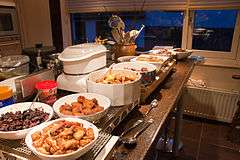
Indonesian and Indo dishes became popular due to the arrival of former Dutch colonials and people of Eurasian descent into the Netherlands, especially after the independence of Indonesia from Dutch colonial rule in 1949. C. Countess van Limburg Stirum writes in her book The Art of Dutch Cooking (1962): "There exist countless Indonesian dishes, some of which take hours to prepare; but a few easy ones have become so popular that they can be regarded as 'national dishes'". She then provides recipes for nasi goreng (fried rice), pisang goreng (baked bananas), lumpia goreng (fried spring rolls), bami (fried noodles), satay (grilled skewered meat), satay sauce (peanut sauce), and sambal oelek (chilli paste).[19] Of the Dutch-Indonesian fusion dishes the best known is the rijsttafel ("Rice table"), which is an elaborate meal consisting of many (up to several dozens) small dishes (hence filling "an entire table"). While popular in the Netherlands, Rijsttafel is now rare in Indonesia itself, while almost every town in the Netherlands has an Indonesian-Chinese restaurant. A popular fusion dish is friet saté or patatje pinda, French fries with satay sauce as condiment, served at snack bars.
Surinamese cuisine is also popular in the Netherlands, especially in the bigger cities. Surinamese establishments commonly offer roti, a staple of the Hindustani community in Suriname, various Surinamese interpretations of Chinese Indonesian cuisine, as well as Surinamese sandwiches (Surinaamse broodjes).
International influences
Italian and American style pizzerias have become widespread. In recent decades, Arab and Turkish dishes have become increasingly popular as well, especially as a snack food. In larger towns and cities, small restaurants selling kebab, shoarma and falafel can be found on virtually any street corner. Nowadays, food from every nook or corner of the world can be found throughout the country, especially in bigger towns and cities, including Greek, Thai, Japanese and even African cuisine.
Structure of meals
Breakfast and lunch




Breakfast and lunch differ little in Dutch cuisine and both consist of bread with a wide variety of cold cuts, cheeses and sweet toppings; such as hagelslag, vlokken, muisjes, gestampte muisjes, chocolate spread, treacle (a thick, dark brown sugar syrup called stroop), apple butter and peanut butter. The Dutch are famous for their dairy products and especially for their cheeses. The vast majority of Dutch cheeses are semi-hard or hard cheeses. Famous Dutch cheeses include Gouda, Edam, and Leyden. A typically Dutch way of making cheese is to blend in herbs or spices during the first stages of the production process. Famous examples of this are cheeses with cloves (usually the Friesian Clove), cumin (most famously Leyden cheese), or nettles.
Dutch bread tends to be very airy, as it is made from yeast dough. From the 1970s onward Dutch bread became predominantly whole grain, with additional seeds such as sunflower or pumpkin seeds often mixed with the dough for taste. Rye bread is one of the few dense breads of the Netherlands. White bread used to be the luxury bread, often made with milk as well as water. A Frisian luxury version of white bread is suikerbrood, white bread with large lumps of sugar mixed with the dough.[20] Kerststol is a traditional Dutch Christmas bread made of bread dough with sugar, dried fruits, raisins, almond paste; and currants, and lemon and orange zest, eaten sliced, spread with butter.
Ontbijtkoek may be eaten as a substitute for a full breakfast, or simply as a snack. It is served as a small slice, usually with butter.
Tea time
Dutch people invite friends over for koffietijd (coffee time), which consists of coffee and cake or a biscuit, served between 10:00 and 11:00 am (before lunch), 4:00 pm (between lunch and dinner) or between 7:00 pm and 8:00 pm (after dinner). The Dutch drink coffee and tea throughout the day, often served with a single biscuit. Dutch thrift led to the famous standard rule of only one cookie with each cup of coffee. It has been suggested that the reasons for this can be found in the Protestant mentality and upbringing in the northern Netherlands. The traditionally Roman Catholic south does not share this tradition as for instance in Limburg, where serving a large vlaai (sweet pie or pastry with filling), cut into eight pieces, is tradition when visitors are expected.
A popular Dutch story (never confirmed) says that in the late 1940s the wife of the then Prime minister, Willem Drees, served coffee and one biscuit to a visiting American diplomat, who then became convinced that the money from the Marshall Plan was being well spent.
Café au lait is also very common. It is called koffie verkeerd (literally "wrong coffee") and consists of equal parts black coffee and hot milk. The Dutch drink tea without milk and the tea is quite a lot weaker than typical English or Irish types of tea which are stronger and are usually taken with milk. Other hot drinks used to include warm lemonade, called kwast (hot water with lemon juice), and anijsmelk (hot milk with aniseed). In the autumn and winter the very popular hot chocolate or chocolate milk is drunk. Both anijsmelk and kwast are hardly drunk any more and have lost their popularity.
Borreltijd
Between 4:00 pm and 5:00 pm it is time for an alcoholic beverage, beer or wine, and a savory snack. This is when the famous 'Bitterballen' can be served. A mini variant on the 'kroket', deep-fried ragout filled balls with a crunchy layer of very fine bread-crumbs. Served with mustard. Borreltijd mostly occurs in the weekends.
Dinner


Dinner, traditionally served early by international standards, starts around or even before 6 o'clock in the evening. The old-fashioned Dutch dinner consists of one simple course: potatoes, meat and vegetables—known under the acronym AVG (aardappelen, vlees, groente).[21] Traditionally potatoes with a large portion of vegetables and a small portion of meat with gravy, or a potato and vegetable stew. Vegetable stews served as side dishes are for example rodekool met appeltjes (red cabbage with apples), or rode bieten (beetroot). Regular spices used in stews of this kind may be bay leaves, juniper berries, cloves, and vinegar, although strong spices are generally used sparingly. Stews are often served with pickles, including augurken (gherkins) or cocktail onions (zilveruitjes). Due to the influx of other countries traditional meals have lost some popularity. Stamppot, mashed potatoes with different options for vegetables, is traditionally eaten in winter. If there is a starter, it is usually soup.
The below listed meals have historic origins as meals for common laborers. In the 17th to 19th century workers worked 10 to 16 hours on farms or in factories in unheated rooms, hence these meals are very heavy on calories and fat and were meant to replenish a laborer's energy.
- Stamppot, boiled potatoes mashed with vegetables and served with a meat and/or gravy, comes in a number of varieties:
- Hutspot, made with potatoes, carrots, and onions served with meats like rookworst (smoked sausage), slow-cooked meat, or bacon. Before potatoes were introduced in Europe hutspot was made from parsnips, carrots, and onions
- Andijviestamppot, raw endive mashed with hot potatoes, served with diced fried spek (a kind of bacon)
- Hete bliksem ("hot lightning"), boiled potatoes and green apples, served with stroop (treacle) or tossed with diced speck
- Zuurkoolstamppot, sauerkraut mashed with potatoes. Served with fried bacon or a sausage. Sometimes curry powder, raisins or slices of pineapple or banana are used to give a stamppot an exotic touch
- Boerenkoolstamppot, curly kale mixed with potatoes, served with gravy, mustard, and rookworst sausage. It is one of the oldest and most popular Dutch dishes. Boerenkool was mentioned in cookbooks from the year 1661. 1661 mashed potatoes were not used in this dish yet, although the sausage was already served with the cabbage in this dish. The dish became popular after a few bad corn-seasons when potatoes became popular as food.[22] Boerenkool is high in carbohydrates, which makes it a popular meal for cold winter days[23]
- Snert, also called erwtensoep, is a very thick pea soup that can be served either as a main dish or as an appetizer and is traditionally eaten during the winter. Snert has a very thick consistency and often includes pieces of pork and rookworst and is almost a stew rather than a soup. The thick consistency of the Dutch pea soup is often described as that "...you should be able to stand a spoon upright in a good pea soup".[22] It is customarily served with roggebrood (rye bread) spread with butter and topped with katenspek, a variety of bacon which is first cooked and then smoked. The meat from the soup may also be put on the rye bread and eaten with mustard.
Meat dishes include:
- Gehaktballen, meatballs (usually made of half pork, half beef)
- Slavink, minced meat wrapped in bacon
- Balkenbrij, a type of liverwurst and meatloaf. The butter based gravy (boterjus), in which the meat has been fried or cooked, is also served. A variant of this, eaten around the IJsselmeer, is butter en eek, where vinegar is added to the gravy.
Flour dishes:
- Pannekoeken
- Poffertjes (miniature pancakes) and spekdik (a Northern variant with bacon).
- Wentelteefjes, similar to French toast).
- Broeder, a type of boiled pudding usually containing buckwheat, is a traditional dinner mainly in West Friesland.
Seafood:
- Mosselen (mussels) are quite popular and commonly served with french fries.
- Kibbeling, chunks of sea fish that are battered and fried.
Dessert

The final course is a sweet dessert, traditionally yogurt with some sugar or vla, thin milk pudding (cooked milk with custard). Other desserts include:
- Vla (vanilla custard) is often mixed with yogurt (and sometimes yoghurt and syrup, making the Dutch vla-flip).
- Broodpap, a bread porridge made from old bread, milk, butter and sugar.
- Griesmeelpudding, a sweet pudding made of semolina and served with red berry coulis.
- grutjespap
- Haagse bluf
- hangop
- karnemelksepap
- rijstebrij (rice pudding)
- krentjebrij (also called watergruwel)
- Jan in de zak
Special occasions



Special occasions call for special foods. The birth of a child is an occasion for serving beschuit met muisjes (Dutch rusk covered with sugared aniseed).
The Dutch festival of Sinterklaas is held on 5 December. Saint Nicholas leaves gifts in the children’s shoes. On this occasion, the Dutch drink hot chocolate milk and eat spice cookies, like speculaas. Special treats distributed by Saint Nicholas' aide Zwarte Piet include pepernoten (irregular shaped small cookies made of rye, honey and anise, often confused with kruidnoten); kruidnoten (gingernut-like biscuits but made with speculaas spices: a mix of cinnamon, pepper, cloves and nutmeg); boterletter or banket (a baked pastry crust filled with a sugared almond paste filling and shaped into a letter); letters made from chocolate; marzipan (often in the shape of animals or other topical items), borstplaat (discs of fondant); and taai-taai.
Christmas in the Netherlands is a typical family holiday. Traditionally there is family brunch with kerststol (fruited raisinbread; often filled with almond paste).[24] Christmas dinner is also a family occasion where rollade (a kind of roulade consisting of spiced pork), roast pork, game or other luxury meat may be served.
On New Year's Eve, Dutch houses smell of the piping hot oil of deep-fat fryers used to prepare oliebollen and appelbeignets (a kind of apple fritter) - not to be mistaken for the appelflap which is completely different. Also ananasbeignets (pineapple fritter) are considered a treat. Oliebollen are yeast dough balls, either plain or filled with glacé fruits, pieces of apple, raisins and sultanas are served with powdered sugar and are a special treat for New Year's Eve. In the 17th century, Dutch settlers also took their oliebollen to the American colonies, where they are now known in a slightly different form as doughnuts.[25][26] In Limburg nonnevotte are sometimes served during New Year's Eve, although it is mostly eaten during Carnival. Around New Years kniepertjes are popular, in particular in the northern provinces.[27]
On birthdays all kinds of cakes and cookies are eaten, including appeltaart (apple pie), bokkepootjes, Bossche bol, dikke koek, cream cake, Fryske dumkes, gevulde koek (cookies filled with almond meal), Groninger koek, janhagel, ketelkoek, kindermanstik, krakeling, krentenwegge, kruidkoek, Limburgse vlaai, ouwewijvenkoek, peperkoek (gingerbread), rijstekoek, spekkoek (originally from Indonesia), sprits, tompouce, trommelkoek, bitterkoekjes, kletskop and stroopwafel. Poffertjes are tiny puffed pancakes served on special occasions, served warm with melting butter and powdered sugar on top. They are mostly combined with a drink: milk, chocolate milk or yogurt drink. Cafeterias all around the Netherlands sell poffertjes. Dutch people call such a restaurant a poffertjeskraam. Poffertjes can be eaten as a dessert after dinner or as a sweet lunch.
Sweets
A famous Dutch sweet is zoute drop, (lit. "salty liquorice") and other liquorice sweets. These sweets are small, black and look much like gums. Similar to Pontefract cakes found in Yorkshire, England. The four types of drop are soft sweet, soft salt, hard sweet and hard salt drop. Liquorice can be bought in shops and pharmacies. It also has a medical function as it is supposed to soften the symptoms throat and stomach aches.[28] Dutch drop is sold in a large variety of shapes and forms. When they are flavored with coconut fondant they are called Engelse drop (lit. "English liquorice"; liquorice allsorts). Other varieties are made with honey (honingdrop), mint (muntdrop), salammoniac (salmiakdrop), or laurel (laurierdrop). Typical shapes are diamonds, ovals, oblongs and as coins. A honeycomb shape for honey drop is also popular. Some manufacturers have introduced speciality ranges where the drop is made in thematic shapes, such as cars (autodrop), farm animals and farm machinery (boerderijdrop), etcetera.
Another popular Dutch sweet is the stroopwafel ("stroop" meaning syrup). A thin waffle cookie, made typically in a pizelle pan, is sliced horizontally and used for sandwiching a layer of syrup, the stroop. Occasionally, crushed hazelnuts will be mixed with the stroop, and the dough may be spiced with cinnamon.
One of the Dutch confectionery specialties is vlaai. It is a sweet pie made with a yeast dough and filled with fruit (such as apple, apricot, pineapple, plum) or berry filling. Other ingredients may include custard and rhubarb. Rice vlaais, stuffed with a rich rice-and-cream filling, are also popular. They can be additionally grafted with fruits, whipped cream or chocolate.[29]
Letterbanket is a type of pastry or cookie that is traditionally eaten on Saint Nicholas Day (December 6, but celebrated as a children's feast on the 5th) and on Christmas Eve in Holland.[30][31]
Alcoholic drinks
Wine plays only a modest role in Dutch cuisine, but there are many brands of beer and strong alcoholic liquor. The most famous Dutch beer producers are Heineken in the west, Grolsch in the east, Alfa and Bavaria in the south. Traditionally, Noord-Brabant and Limburg had a strong beer tradition, brewing many different types of beer (not unlike beer in Belgium). The Dutch cities in the west used to have a long brewing tradition as well, but in the 20th century, big brewers took over many of these smaller breweries or offered them a license to sell their beer brand, while stopping their own production. In the 21st century, many new microbreweries were founded, brewing topfermenting beers in many different styles. In September 2013, there were 184 active breweries in the Netherlands.[32] Popular styles include bock, trappist ale, stout and wheat beer.
Of the range of bitters, Beerenburg is the most famous. Strong liquors include Jenever (distilled malt wine and the precursor to Gin), Brandewijn (brandy) and Vieux (Dutch brandy, an imitation Cognac), but also Kandeel (made from white wine), Kraamanijs (a liquor made from aniseed), Oranjebitter (an orange-flavored brandy, which is traditionally served on festivities surrounding the royal family), Advocaat, Boerenjongens (raisins in brandy), and Boerenmeisjes (apricots in brandy).
Fast food

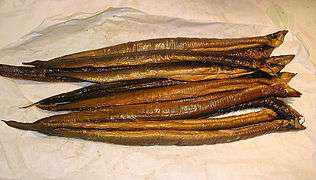
The Dutch have their own types of fast food, sold at a snackbar. A Dutch fast food meal often consists of a portion of French fries (called patat or friet), with a sauce and a meat product. The most common sauce to accompany French fries is fritessaus (a low fat mayonnaise substitute), while others can be ketchup or currysaus, hot peanut sauce, a pickle relish of chopped vegetables and spices, such as piccalilli or joppiesaus. Sometimes the French fries are served with a combinations of different sauces, most famously speciaal (lit. "special"), which consists of mayonnaise with spiced ketchup and chopped onions, and oorlog (lit. "war"), which consists of a friet special covered in a generous amount of hot peanut sauce. A recently introduced variety from Rotterdam is the kapsalon (lit. "barbershop"), consisting of either shawarma or döner, and with fries, salad, cheese and various sauces.
Snacks made with meat are usually deep fried. This includes the frikandel (a skinless minced meat sausage), and the kroket (a meat ragout roll covered in breadcrumbs). They are available in bread rolls - Broodje kroketten - to take away. A smaller, round version of the kroket, the bitterbal, is often served with mustard as a snack in bars but also at official receptions. Regional snacks include the eierbal (a combination of egg and ragout) in the north and east of the country, and the slightly spiced Brabants worstenbrood or saucijzenbroodjes, slightly spiced sausage meat baked in pastry (similar to the English sausage roll).
Other snacks are the Indonesian-inspired bamihap or bamischijf (a disk shaped mie goreng patty which is covered with breadcrumbs and deep-fried), nasibal (similar to the bamischijf, but then ball shaped and filled with nasi goreng), and kaassoufflé (lit. "cheese soufflé" but in fact a deep fried puff pastry envelope with a small amount of cheese in the center, popular amongst vegetarians).
Fish is also sold as fast food at the so-called viskraam, most often street stalls and market stalls that specialise only in prepared fish products. The Netherlands is famous for its raw herring, optionally served together with chopped raw onions and gherkins, and which is eaten by lifting the herring high up into the air by its tail, and then biting into it upwards (except for Amsterdam, where the herring is cut to pieces and served on paper platter). Raw herring is also commonly sold in a soft white bun. Other popular fish snacks are kibbeling (deep-fried nugget-sized chunks of cod), lekkerbek (deep-fried cod, similar to the British Fish and chips, but delicately spiced and with a more tempura-like batter), gerookte paling (smoked eel), and rolmops.
Gallery
 With two meals a day using bread, bread comes in many varieties
With two meals a day using bread, bread comes in many varieties Krentenbollen (currant buns) are sometimes eaten with butter but sometimes also with cheese, for breakfast, lunch or as a snack
Krentenbollen (currant buns) are sometimes eaten with butter but sometimes also with cheese, for breakfast, lunch or as a snack Stroopwafels (syrup waffles) are a treat consisting of waffles with caramel-like syrup filling in the middle
Stroopwafels (syrup waffles) are a treat consisting of waffles with caramel-like syrup filling in the middle A seasonal dish, asparagus is popularly eaten with ham, egg, potatoes and a butter sauce
A seasonal dish, asparagus is popularly eaten with ham, egg, potatoes and a butter sauce- A simple Dutch meal traditionally consists of meat, potatoes, butter gravy, a boiled vegetable, and some salad
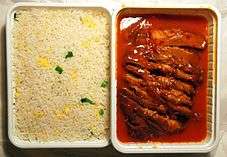 Babi panggang speciaal was, although seemingly Indonesian-Chinese in origin, probably devised in the Netherlands
Babi panggang speciaal was, although seemingly Indonesian-Chinese in origin, probably devised in the Netherlands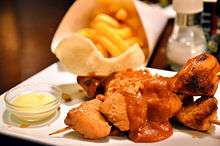 Saté is another Indonesian dish that has become incorporated into Dutch cuisine
Saté is another Indonesian dish that has become incorporated into Dutch cuisine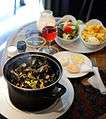 Mussels are usually served with fries and dipping sauces
Mussels are usually served with fries and dipping sauces Sudderlapjes is slowly simmered beef, most often served with potatoes
Sudderlapjes is slowly simmered beef, most often served with potatoes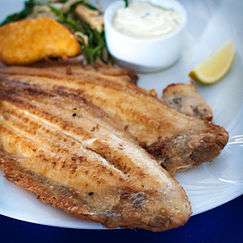 Gebakken sliptong: young sole (also known as "slip") fried in butter
Gebakken sliptong: young sole (also known as "slip") fried in butter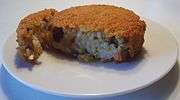 A nasischijf cut open showing the fried rice inside the deep fried snack
A nasischijf cut open showing the fried rice inside the deep fried snack- Kibbeling are battered deep fried pieces of fish which are popular as a snack
- Poffertjes are made in a special, so-called, poffertjespan
 Griesmeelpudding met rode bessensaus is semolina pudding served with redcurrant sauce
Griesmeelpudding met rode bessensaus is semolina pudding served with redcurrant sauce- Hutspot
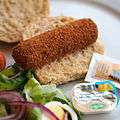 A broodje kroket served for lunch
A broodje kroket served for lunch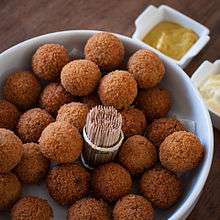 Bitterballen are small snacks similar to the larger kroketten and are usually served with mustard
Bitterballen are small snacks similar to the larger kroketten and are usually served with mustard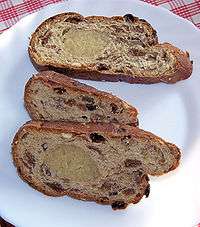 Slices of kerststol showing the almond paste in the middle
Slices of kerststol showing the almond paste in the middle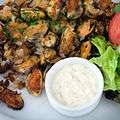 Gebakken mosselen (fried mussels) are cooked mussels fried with butter and onions
Gebakken mosselen (fried mussels) are cooked mussels fried with butter and onions Oysters, "platte Zeeuwse oester".
Oysters, "platte Zeeuwse oester".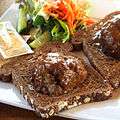 Broodje bal a slice of bread with a meatball and gravy, halved meatball served on slices of Dutch whole wheat bread.
Broodje bal a slice of bread with a meatball and gravy, halved meatball served on slices of Dutch whole wheat bread.- Slices of meat with hard boiled eggs in the middle.
 Eating "Hollandse Nieuwe" (Dutch brined herring) the Dutch way.
Eating "Hollandse Nieuwe" (Dutch brined herring) the Dutch way. A saucijzenbroodje is a popular snack in the Netherlands. It is the Dutch variant of a sausage roll.
A saucijzenbroodje is a popular snack in the Netherlands. It is the Dutch variant of a sausage roll.
See also
| Life in the Netherlands |
|---|
 |
|
Government |
- Wannée Kookboek (1910- )
- Nieuwe Haagse Kookboek (1934- )
- List of Dutch chefs
- Beer in the Netherlands
- Dutch cheese markets
- FEBO - a chain of fast food outlets that uses vending machines to serve krokets, frikandellen, kaassoufflés, and other items
- Pannekoek
- Babi panggang - a Dutch/Indonesian/Chinese fusion dish
- Spekkoek - a Dutch/Indonesian cake
- Coleslaw - from the Dutch words "kool" (cabbage) and "sla" (salad)
- Rijsttafel - Dutch for rice table. Indonesian styled dish. Side dishes served in small portions, accompanied by rice prepared in several different ways
- Hollandse Nieuwe - Fresh (raw) Herring
Footnotes
- 1 2 3 4 The Cambridge world history of food. 2 (2000), Volume 2, p.1232
- ↑ "William Buckels". aboutus.org.
- ↑ "Dutch Food & Eating Out - Holland.com". holland.com.
- ↑ "Kantoor of bedrijfsruimte huren in Rotterdam of Zwolle". wereldexpat.nl. Retrieved 21 May 2015.
- ↑ Gastronomie: De Nederlandse keuken
- ↑ Ukers, William H (1922). "The Introduction of Coffee into Holland". All About Coffee. New York: Tea and Coffee Trade Journal. ISBN 0-8103-4092-5. Retrieved February 12, 2010.
- ↑ Dobelis, Inge N, ed. (1986). Magic and medicine of plants. Pleasantville, NY: Reader's Digest. pp. 370–371. ISBN 0-89577-221-3.
- ↑ Fischer, Dieter. "History of Indonesian coffee". Specialty Coffee Association of Indonesia. Retrieved February 12, 2010.
- ↑ Bakkerijmuseum: Geschiedenis van speculaas
- ↑ http://www.culinaryhistoriansny.org/files/Newsletters/Newsletter_2002_F.pdf
- ↑
- ↑ De verstandige kok. Marleen Willebrands ISBN 9077455205
- ↑ Karin Engelbrecht. "Kastelenkookboek Cookbook Review". About.com Food. Retrieved 21 May 2015.
- 1 2 3 4 Wintle, Michael (2006). "Diet and Modernization in the Netherlands During the Nineteenth and Early Twentieth Centuries". In Thomas M. Wilson. Food, Drink and Identity in Europe. Rodopi. pp. 63–84. ISBN 9789042020863. Retrieved 28 December 2012.
- ↑ De rijke Hollandse dis WereldExpat Magazine
- ↑ Spierings, T. "Dutch Cuisine. "
- ↑ http://www.warenkennis.nl/graan/soorten.htm
- ↑ History of Mostard
- ↑ C. Countess van Limburg Stirum: The Art of Dutch Cooking; First published in 1962 by Andre Deutsch Limited, London; p.179-p.185
- ↑ Friesian Sugar Bread World Cook
- ↑ "Elke dag feest met aardappels, groente, vlees" (in Dutch). RTL Nieuws. 28 January 2015. Retrieved 15 June 2015.
- 1 2 Hester, Carla Dutch food and eating habits The Holland Ring, 28 October 2008
- ↑ Farmers Cabbage with Smoked Sausage (Boerenkool Met Worst) Recipe Land, 14 November 2008
- ↑ "Dutch Holiday Recipes on Dutchfood". About.com. Retrieved 1 February 2009.
- ↑ "History of the donut". wentz.net. Archived from the original on February 11, 2014.
- ↑ See entries for oliebol and oliekoek in Frederic Gomes Cassidy; Joan Houston Hall (1985). Dictionary of American Regional English: I-O. Harvard UP. p. 874. ISBN 978-0-674-20519-2.
- ↑ nl:Kniepertie
- ↑ Habets, Joep Calvinistisch snoepen NRC Handelsblad, 3 March 2001
- ↑ "Rice-Cakes". Dutchcakeshop.com. Retrieved 2010-11-17.
- ↑ Howard, C. (2012). Faiths and Festivals: A guide to the religions and celebrations in our multicultural society. Practical pre-school. Andrews UK Limited. ISBN 978-1-907241-89-5.
- ↑ Wernecke, H.H. (1959). Christmas Customs Around the World. Westminster Press. p. 53. ISBN 978-0-664-24258-9.
- ↑ http://www.cambrinus.nl/cambrinus/|title=Cambrinus|work=cambrinus.nl|accessdate=21 May 2015
External links
| Wikimedia Commons has media related to Cuisine of the Netherlands. |
- Dutch food and eating habits
- Hutspot recipe
- The Dutch Table - an online resource for Dutch recipes
- Food of the Dutch Photo-documentary by photographer Wim Klerkx, 2005–2007
